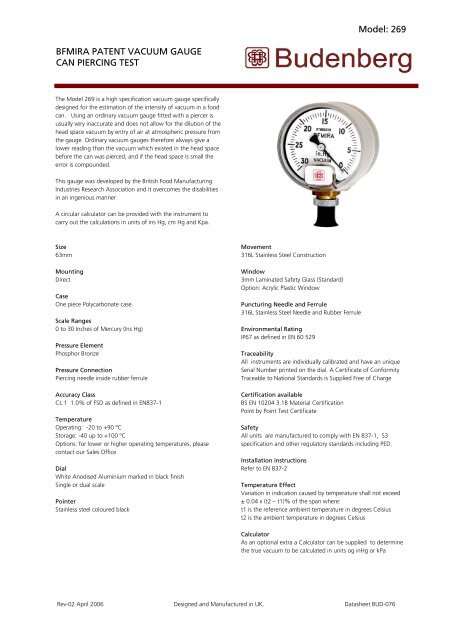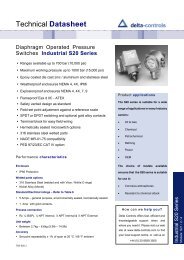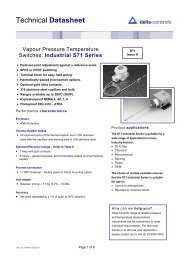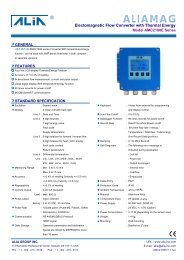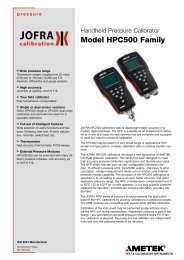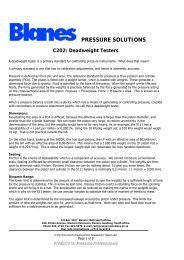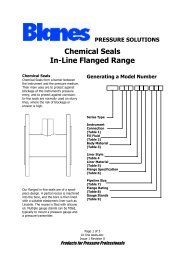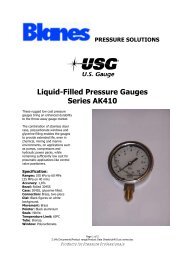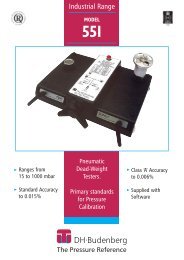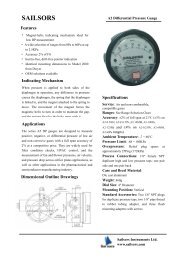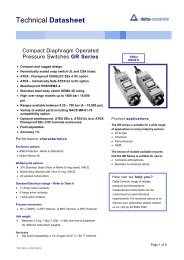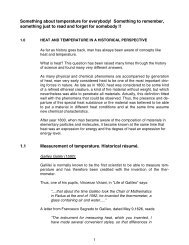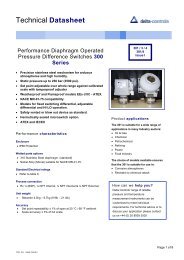Model: 269 BFMIRA PATENT VACUUM GAUGE CAN PIERCING ...
Model: 269 BFMIRA PATENT VACUUM GAUGE CAN PIERCING ...
Model: 269 BFMIRA PATENT VACUUM GAUGE CAN PIERCING ...
Create successful ePaper yourself
Turn your PDF publications into a flip-book with our unique Google optimized e-Paper software.
<strong>Model</strong>: <strong>269</strong><br />
<strong>BFMIRA</strong> <strong>PATENT</strong> <strong>VACUUM</strong> <strong>GAUGE</strong><br />
<strong>CAN</strong> <strong>PIERCING</strong> TEST<br />
The <strong>Model</strong> <strong>269</strong> is a high specification vacuum gauge specifically<br />
designed for the estimation of the intensity of vacuum in a food<br />
can. Using an ordinary vacuum gauge fitted with a piercer is<br />
usually very inaccurate and does not allow for the dilution of the<br />
head space vacuum by entry of air at atmospheric pressure from<br />
the gauge. Ordinary vacuum gauges therefore always give a<br />
lower reading than the vacuum which existed in the head space<br />
before the can was pierced, and if the head space is small the<br />
error is compounded.<br />
This gauge was developed by the British Food Manufacturing<br />
Industries Research Association and it overcomes the disabilities<br />
in an ingenious manner<br />
A circular calculator can be provided with the instrument to<br />
carry out the calculations in units of ins Hg, cm Hg and Kpa.<br />
Size<br />
63mm<br />
Movement<br />
316L Stainless Steel Construction<br />
Mounting<br />
Direct<br />
Case<br />
One piece Polycarbonate case.<br />
Window<br />
3mm Laminated Safety Glass (Standard)<br />
Option: Acrylic Plastic Window<br />
Puncturing Needle and Ferrule<br />
316L Stainless Steel Needle and Rubber Ferrule<br />
Scale Ranges<br />
0 to 30 Inches of Mercury (Ins Hg) Environmental Rating<br />
IP67 as defined in EN 60 529<br />
Pressure Element<br />
Phosphor Bronze<br />
Traceability<br />
All instruments are individually calibrated and have an unique<br />
Pressure Connection<br />
Serial Number printed on the dial. A Certificate of Conformity<br />
Piercing needle inside rubber ferrule<br />
Traceable to National Standards is Supplied Free of Charge<br />
Accuracy Class<br />
Certification available<br />
CL:1 1.0% of FSD as defined in EN837-1<br />
BS EN 10204 3.1B Material Certification<br />
Point by Point Test Certificate<br />
Temperature<br />
Operating: -20 to +90 ºC<br />
Safety<br />
Storage: -40 up to +100 ºC<br />
All units are manufactured to comply with EN 837-1, S3<br />
Options: for lower or higher operating temperatures, please<br />
specification and other regulatory standards including PED.<br />
contact our Sales Office<br />
Installation instructions<br />
Dial Refer to EN 837-2<br />
White Anodised Aluminium marked in black finish<br />
Single or dual scale<br />
Temperature Effect<br />
Variation in indication caused by temperature shall not exceed<br />
Pointer<br />
± 0.04 x (t2 – t1)% of the span where:<br />
Stainless steel coloured black<br />
t1 is the reference ambient temperature in degrees Celsius<br />
t2 is the ambient temperature in degrees Celsius<br />
Calculator<br />
As an optional extra a Calculator can be supplied to determine<br />
the true vacuum to be calculated in units og inHg or kPa<br />
Rev-02 April 2006 Designed and Manufactured in UK. Datasheet BUD-076
Dimensions <strong>Model</strong> : <strong>269</strong><br />
Theory<br />
It would be possible to calculate the true vacuum in a can from the vacuum gauge indication as normally obtained<br />
provided that the internal volume of the gauge were known, and also that the volume of the head space could be<br />
accurately measured. The measurement of the volume of the head space in a can is not however a simple matter.<br />
As in most cases the actual volume is governed to a greater or lesser extent by the degree of vacuum because of<br />
the flexibility of the lid of the can, an accurate determination of the head space volume by direct measurement<br />
would not be possible.<br />
Suppose, however that having made a determination of the vacuum in a can in the usual manner with a puncturing<br />
gauge, a second known volume of air at known pressure and at the same temperature as the head space gas is<br />
introduced into the system. With the vacuum gauge still in position on the test can, a second gauge reading is<br />
obtained. From these two readings it is possible to calculate the original vacuum in the can without requiring to<br />
know the volume of the head space.<br />
Maintenance of <strong>Model</strong> <strong>269</strong><br />
The <strong>BFMIRA</strong> vacuum gauge is a scientific instrument and should be treated accordingly. Ensure that it is not left<br />
exposed to those conditions which would corrode metal or rot the rubber ferrule.<br />
The rubber ferrule should be removed from time to time and the puncturing needle wiped clean. If after repeated<br />
use the puncturing needle has become blunted, any slight burring of the cutting edge should be carefully removed<br />
with a fine file.<br />
The gauge is fitted with a fine gauze filter at the head of the puncturing needle. This filter may require cleaning<br />
after prolonged use, it can be removed by unscrewing the knurled nut carrying the puncturing needle.<br />
he valve is a standard Schrader type, should this valve fail, as indicated by a failure to obtain a second reading<br />
with a vacuum gauge, the valve can easily be removed and cleaned or a new one fitted.<br />
It is essential to ensure that all joints are vacuum tight after carrying out cleaning operations and valve replacements.<br />
Spares<br />
Rubber Ferrule<br />
Piercing Needle assembly complete<br />
Button<br />
Cap<br />
Valve Spring<br />
Button<br />
Cap<br />
Valve Spring<br />
Specifications and dimensions in this leaflet, are subject to change without prior notice.<br />
Budenberg Gauge Co Ltd<br />
4 Gilchrist Road. Northbank Industrial Park. Irlam. Manchester. M44 5AY.<br />
Tel : +44 (0)870 442 5441. Fax : +44 (0)870 787 7350.<br />
Email : sales@budenberg.co.uk Web: www.budenberginstruments.com


